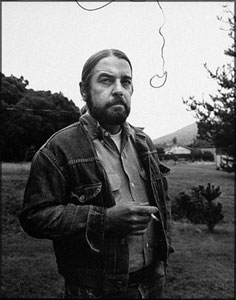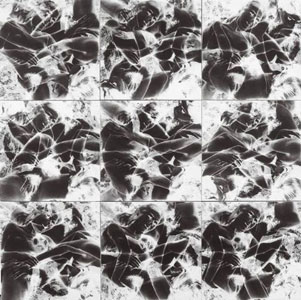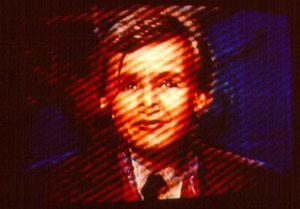
by Christopher Knight
 |
Robert Heinecken, an artist who was instrumental in changing the way photographs are considered in the American cultural landscape, died on May 15th at a nursing home in Albuquerque, N.M. He was 74. Heinecken, who had relocated to New Mexico after living and working principally in Los Angeles for more than 50 years, suffered from the effects of Alzheimer's disease since 1994, said his wife, Joyce Neimanas. In the 1960s, Heinecken began to develop an approach to photographs that was distinctive in the history of the medium. He sometimes described himself as a para-photographer because his work stood ''beside'' or ''beyond'' traditional ideas associated with photography.
|
| © Jerry Uelsmann, 1973 |
Essentially, the artist decided that in the wake of the media explosion that had come to characterize contemporary life, enough photographs existed in the world. Rather than make more, he would manipulate existing ones. His art became an attempt to clarify, reveal and sometimes confound the subliminal social, political and artistic codes they contain.
Heinecken was among the first to consider himself an artist who used photographs, not a photographer who made them. Today that approach is common. But in the late 1960s, when Heinecken published an influential portfolio of 25 prints titled ''Are You Rea,'' the radical nature of the experiment was largely unprecedented. ''Are You Rea'' was made after lengthy analysis of hundreds of commercially published news, fashion, lifestyle and other magazines. Heinecken found that when magazine pages were placed on a light table, the images on both sides of the sheet visually merged in unexpected ways.
Sometimes the resulting montages, although not planned by the layouts' designers, were stimulating pictorially and conceptually.
The black-and-white images of Heinecken's innovative series pay homage to photographer Man Ray, the Surrealist artist who was among the innovators of an early technique for printing photographs made without a camera. Ray instead placed objects directly on a negative and exposed it to light.
 |
Nine Squares © Robert Heinecken |
Similarly, Heinecken treated the two sides of a magazine page as if it were a found negative, which he then exposed directly onto an offset printing plate. The result was a layered black-and-white image, in which the original areas of dark and light were reversed. The portfolio, in addition to acknowledging the artistic legacy of Man Ray, had the appearance and function of a social X-ray.
Robert Friedli Heinecken was born in Denver on Dec. 29, 1931, the son of an itinerant Lutheran minister. The family moved to Southern California in 1942, and he was raised in Riverside.
In 1951 Heinecken entered the University of California-Los Angeles, but he did not graduate until 1959.
Throughout his career Heinecken continued to work with found images, including undeveloped rolls of pornographic film salvaged from the many commercial graphic houses in Los Angeles. Usually in an effort to articulate the social and sexual mores of the time.
 |
© Robert Heinecken |
This approach to photographs, along with Heinecken's frequent effort to coax poetic meanings from their juxtaposition and layering, owed something to his friendship with the influential and charismatic Los Angeles assemblage artist, poet and small-press publisher Wallace Berman. He met Berman in 1962, just as Heinecken was initiating the photography program at UCLA.
Heinecken also experimented with the Polaroid SX-70 instant camera system and made several series by photographing newscasters and political figures directly off his television screen.
 |
© Robert Heinecken, 1985 CBS Docudrama in Words in Pictures (Peter Jennings and Deborah Norville) photo lithograph |
Heinecken's work is in the collections of numerous art museums internationally, and examples are included in the large survey exhibition, ''Los Angeles 1955-1985: Birth of an Artistic Capital,'' currently at the Centre Georges Pompidou in Paris. His archives are held at the Center for Creative Photography at the University of Arizona, Tucson.
In addition to Neimanas, he is survived by Geoffrey Heinecken, Kathe Hull and Karol Mora, his children from his first marriage, and by three grandchildren. The Robert Heinecken Memorial Fund has been established at the University of New Mexico, Albuquerque.
© Los Angeles Times
Christopher Knight